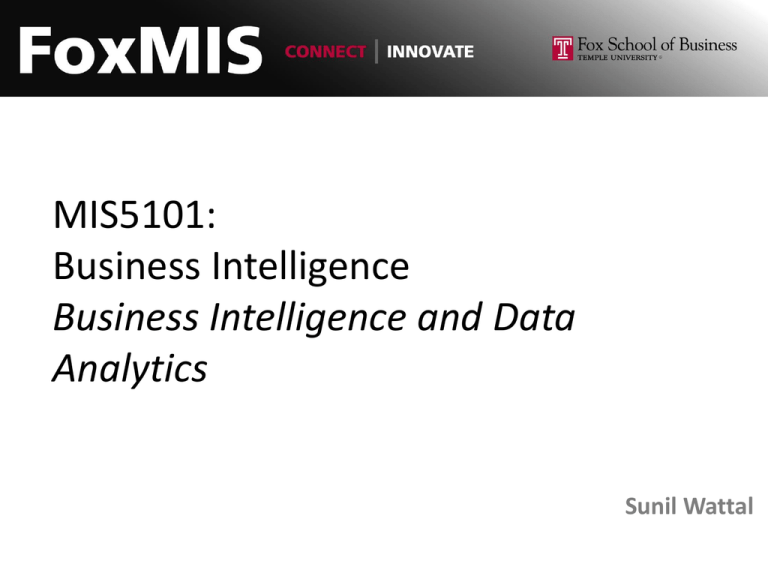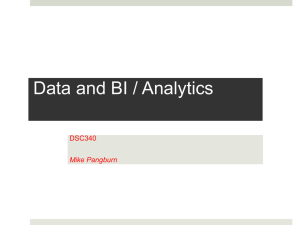click here for slides
advertisement

MIS5101:
Business Intelligence
Business Intelligence and Data
Analytics
Sunil Wattal
Analytics is
Extraction of implicit,
previously unknown,
and potentially useful
information from data
Exploration and
analysis of large data
sets to discover
meaningful patterns
Case Study:
Matchmaking with
Math
What did they do?
How did they do it?
What do you think of the
result?
What do you think of the
process?
Analytics Techniques
Decision
Trees
Clustering
Association
Rule Mining
Decision Trees
Used to classify data
according to a
pre-defined outcome
Based on
characteristics
of that data
http://www.mindtoss.com/2010/01/25/five-second-rule-decision-chart/
Uses
• Predict whether a customer should receive a
loan
• Flag a credit card charge as legitimate
• Determine whether an investment will pay off
A more realistic one…
Will a customer buy some product given their
demographics?
What are the
characteristics of
customers who
are likely to buy?
http://onlamp.com/pub/a/python/2006/02/09/ai_decision_trees.html
Clustering
Used to determine
distinct groups of data
Based on data across
multiple dimensions
Uses
• Customer segmentation
• Identifying patient care groups
• Performance of business sectors
Here you have
four clusters of
web site
visitors.
What does this
tell you?
http://www.datadrivesmedia.com/two-ways-performance-increases-targeting-precision-and-response-rates/
Association Rule Mining
Find out which items
predict the occurrence of
other items
Also known as “affinity
analysis” or “market
basket” analysis
Uses
• What products are bought together?
• Amazon’s recommendation engine
• Telephone calling patterns
Market-Basket Transactions
Basket
1
2
3
Items
Bread, Milk
Bread, Diapers, Beer, Eggs
Milk, Diapers, Beer, Coke
4
5
Bread, Milk, Diapers, Beer
Bread, Milk, Diapers, Coke
Association Rules
from these
transactions
XY
(antecedent consequent)
{Diapers} {Beer},
{Milk, Bread} {Diapers}
{Beer, Bread} {Milk},
{Bread} {Milk, Diapers}
Core idea: The itemset
Itemset
A group of items of interest
{Milk, Beer, Diapers}
Basket
Association rules express
relationships between itemsets
XY
{Milk, Diapers} {Beer}
“when you have milk and diapers,
you also have beer”
Items
1
Bread, Milk
2
Bread, Diapers, Beer, Eggs
3
Milk, Diapers, Beer, Coke
4
Bread, Milk, Diapers, Beer
5
Bread, Milk, Diapers, Coke
Support
• Support count ()
– In how many baskets does the itemset
appear?
– {Milk, Beer, Diapers} = 2
(i.e., in baskets 3 and 4)
• Support (s)
– Fraction of transactions that contain all
items in X Y
– s({Milk, Diapers, Beer}) = 2/5 = 0.4
X
Basket
Items
1
Bread, Milk
2
Bread, Diapers, Beer, Eggs
3
Milk, Diapers, Beer, Coke
4
Bread, Milk, Diapers, Beer
5
Bread, Milk, Diapers, Coke
2 baskets have milk,
beer, and diapers
Y
• You can calculate support for both X and Y
separately
– Support for X = 3/5 = 0.6
– Support for Y = 3/5 = 0.6
5 baskets total
Confidence
• Confidence is the strength
of the association
– Measures how often items in
Y appear in transactions that
contain X
c
Basket
Items
1
Bread, Milk
2
Bread, Diapers, Beer, Eggs
3
Milk, Diapers, Beer, Coke
4
Bread, Milk, Diapers, Beer
5
Bread, Milk, Diapers, Coke
( X Y ) (Milk, Diapers, Beer) 2
0.67
(X )
(Milk, Diapers)
3
c must be between 0 and 1
1 is a complete association
0 is no association
This says 67% of the times
when you have milk and
diapers in the itemset you
also have beer!
Some sample rules
Association Rule
Support (s) Confidence (c)
{Milk,Diapers} {Beer}
2/5 = 0.4
2/3 = 0.67
{Milk,Beer} {Diapers}
2/5 = 0.4
2/2 = 1.0
{Diapers,Beer} {Milk}
2/5 = 0.4
2/3 = 0.67
{Beer} {Milk,Diapers}
2/5 = 0.4
2/3 = 0.67
{Diapers} {Milk,Beer}
2/5 = 0.4
2/4 = 0.5
{Milk} {Diapers,Beer}
2/5 = 0.4
2/4 = 0.5
Basket
1
Items
Bread, Milk
2
Bread, Diapers, Beer, Eggs
3
Milk, Diapers, Beer, Coke
4
Bread, Milk, Diapers, Beer
5
Bread, Milk, Diapers, Coke
But don’t blindly follow the numbers
i.e., high confidence suggests a strong
association…
• But this can be deceptive
• Consider {Bread} {Diapers}
• Support for the total itemset is 0.6 (3/5)
• And confidence is 0.75 (3/4) – pretty high
• But is this just because both are frequently
occurring items (s=0.8)?
• You’d almost expect them to show up in the
same baskets by chance
Lift
Takes into account how co-occurrence differs
from what is expected by chance
– i.e., if items were selected independently from
one another
s( X Y )
Lift
s ( X ) * s (Y )
Support for total itemset X and Y
Support for X times support for Y
Lift Example
• What’s the lift for the rule:
{Milk, Diapers} {Beer}
• So X = {Milk, Diapers}
Y = {Beer}
s({Milk, Diapers, Beer}) = 2/5 = 0.4
s({Milk, Diapers}) = 3/5 = 0.6
s({Beer}) = 3/5 = 0.6
0.4
0.4
So Lift
1.11
0.6 * 0.6 0.36
Basket
Items
1
Bread, Milk
2
Bread, Diapers, Beer, Eggs
3
Milk, Diapers, Beer, Coke
4
Bread, Milk, Diapers, Beer
5
Bread, Milk, Diapers, Coke
When Lift > 1, the
occurrence of
X Y together is
more likely than what
you would expect by
chance
Another example
Checking Account
Savings
Account
No
Yes
No
500
3500
4000
Yes
1000
5000
6000
10000
Are people more inclined to have a
checking account if they have a savings
account?
Support ({Savings} {Checking}) = 5000/10000 = 0.5
Support ({Savings}) = 6000/10000 = 0.6
Support ({Checking}) = 8500/10000 = 0.85
Confidence ({Savings} {Checking}) = 5000/6000 = 0.83
0.5
0.5
Lift
0.98
0.6 * 0.85 0.51
Answer: No
In fact, it’s
slightly less
than what
you’d expect by
chance!
But this can be overwhelming
Thousands of
products
Many
customer types
Millions of
combinations
So where do you start?
Selecting the rules
• We know how to
calculate the measures
for each rule
– Support
– Confidence
– Lift
• Then we set up
thresholds for the
minimum rule strength
we want to accept
The steps
• List all possible
association rules
• Compute the support
and confidence for
each rule
• Drop rules that don’t
make the thresholds
• Use lift to further
check the association
Once you are confident in a rule, take
action
{Milk, Diapers} {Beer}
Possible Marketing
Actions
• Create “New Parent Coping
Kits” of beer, milk, and diapers
• What are some others?




